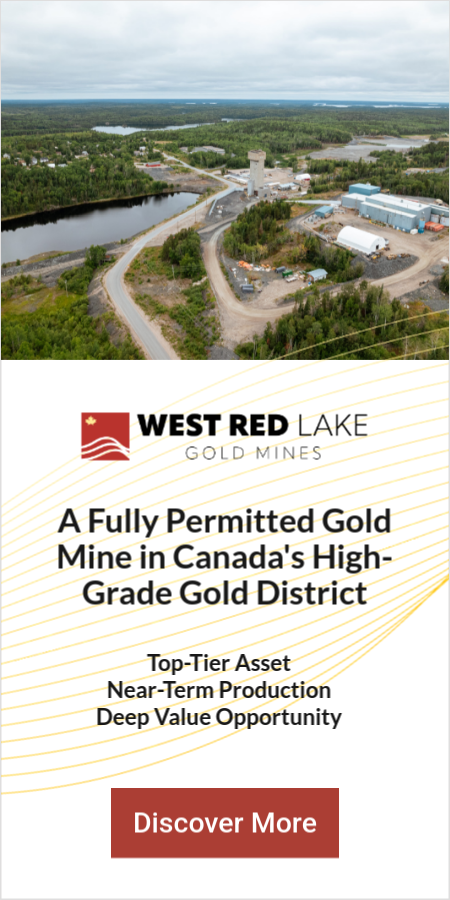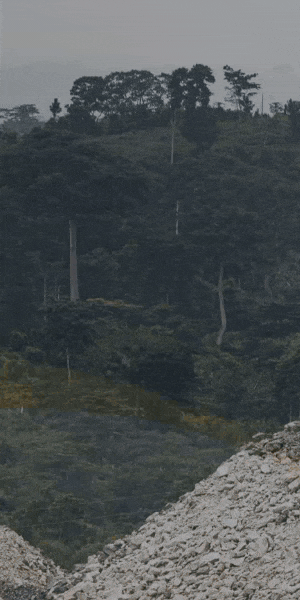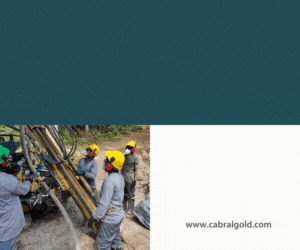U.S. Gold Corp Positions for Production as Strategic Wyoming Acquisitions Solidify Development Timeline

U.S. Gold Corp completes strategic Wyoming acquisitions removing CK Gold Project development obstacles as feasibility study nears completion with gold testing $4,080 resistance levels.
- U.S. Gold Corp (NASDAQ: USAU) has secured critical surface rights and water access through strategic Wyoming property acquisitions, removing key permitting obstacles for its fully-permitted CK Gold Project.
- The company's February 2025 Pre-Feasibility Study projects 110,000+ ounces annual gold-copper production over 10 years with robust economics: 36% pre-tax IRR and $937/oz all-in sustaining costs at $2,100 gold.
- With gold trading near $4,080 resistance and analysts forecasting renewed upside in early 2026, CK Gold's location 90 minutes from Denver positions it as America's next strategic precious metals producer.
- The company controls three complementary U.S. assets: near-term production in Wyoming, district-scale Cortez Trend exploration in Nevada, and historic Idaho gold territory, all in mining-friendly jurisdictions.
- At 14.4 million shares outstanding with significant insider ownership, USAU offers leveraged exposure to rising gold prices through a tightly-held capital structure advancing toward construction decisions.
U.S. Gold Corp's recent property acquisitions in Wyoming arrive as gold markets probe critical technical levels that could define the next major price leg. With spot gold testing $4,080 resistance this week and medium-term forecasts pointing to fresh highs in early 2026, the company's fully-permitted CK Gold Project offers investors direct exposure to domestic production economics that improve dramatically at higher metal prices.
The strategic land purchases announced this week address the final surface access requirements for the CK Gold Project, located approximately 20 miles west of Cheyenne in southeast Wyoming. By securing both surface rights and water access agreements, U.S. Gold has eliminated permitting uncertainties that typically plague junior developers, positioning the asset for accelerated development timelines should financing conditions align with the anticipated gold price strength.
Market context amplifies the strategic value of these acquisitions. Saxo Bank's Ole Hansen projects gold consolidation through year-end before "the next leg up" materializes in early 2026, while technical analysts at FXStreet identify the $4,080 level as the gateway to extended gains. For development-stage producers like U.S. Gold, this setup creates optimal conditions: sufficient time to finalize engineering and financing arrangements before metal prices potentially breach the $4,400 threshold that transforms project economics.
Company Overview: Rare Permitting Advantage in Domestic Gold Space
U.S. Gold Corp distinguishes itself in the junior mining sector through an asset portfolio concentrated entirely within stable U.S. jurisdictions, a strategic positioning that carries escalating value as supply chain security dominates policy discussions. The company's flagship CK Gold Project received all major Wyoming permits in 2024, including the critical Mine Operating Permit, air quality authorization, and water discharge permits, a permitting trifecta that typically requires 5-7 years to achieve.
The management team brings proven mine-building credentials to execution risk. President and CEO George Bee previously held senior vice president roles at Barrick Gold and managed world-class projects across eight countries for Rio Tinto and Anglo American. This operational depth extends through the technical team, with VP of Exploration Kevin Francis contributing 35 years of experience ranging from principal geologist positions to vice president of technical services roles.
U.S. Gold's asset base balances near-term production potential with exploration upside across three properties. The CK Gold Project in Wyoming contains 1.67 million gold-equivalent ounces in proven and probable reserves, while the Keystone Project occupies 20 square miles along Nevada's prolific Cortez Trend, 11 miles south of Nevada Gold Mines' Cortez Complex, which hosts over 51 million ounces. The Challis Gold Project in Idaho adds historic mining district exposure in a jurisdiction ranked eighth globally by the Fraser Institute for mining investment attractiveness.
Strategic Significance: Wyoming Acquisitions Remove Development Obstacles
The recent property acquisitions solve critical path challenges that frequently derail mine development timelines. Surface rights ownership streamlines construction permitting, eliminates third-party access negotiations, and provides flexibility for infrastructure placement that optimizes capital efficiency. Water rights, particularly in semi-arid Western states, represent equally essential project components; securing these assets removes uncertainty around process water supply and positions the company to proceed with detailed engineering.
According to George Bee, the acquisitions "represent a significant milestone in advancing the CK Gold Project toward development." The strategic importance extends beyond immediate development benefits. By controlling surface access, U.S. Gold gains operational flexibility to pursue the aggregate and rail ballast opportunities identified in the Pre-Feasibility Study, waste rock byproducts that market studies suggest could support one million tons annually of industrial material sales, creating additional revenue streams not captured in base case economics.
The Wyoming land consolidation also enhances the project's post-mining legacy value proposition. Technical studies envision converting the exhausted open pit into water storage capacity for Cheyenne's growing population, potentially eliminating traditional reclamation costs while creating long-term infrastructure value. This innovative closure scenario differentiates CK Gold from typical mining projects and strengthens community support, a critical intangible in modern mine permitting and operation.
February 2025 Pre-Feasibility Study: Robust Economics at Conservative Metal Prices
Samuel Engineering's SK-1300 Technical Report released in February 2025 established economic parameters that position CK Gold favorably within the development-stage gold sector. The study models 10.2 years of production averaging 111,250 gold-equivalent ounces annually, with initial three-year output reaching 143,278 ounces as higher-grade zones are mined early in the sequence.
At base case assumptions of $2,100 gold and $4.10 copper, the project generates $459 million pre-tax net present value (5% discount) with 36% internal rate of return. All-in sustaining costs of $937 per gold-equivalent ounce preserve robust margins even if metal prices retreat from current levels near $4,000. Initial capital requirements total $277 million, with sustaining capital of just $13 million over the mine life, a modest reinvestment profile that supports strong free cash flow generation once production commences.
The study's metal price assumptions, established nine months ago, now appear notably conservative given gold's subsequent rally through $4,000. Each $100 increase in gold prices above the $2,100 base case adds approximately $69 million to pre-tax NPV while improving IRR by roughly 3 percentage points. At current spot prices near $4,000, project economics would show pre-tax NPV approaching $900 million with IRR exceeding 60%, metrics that would place CK Gold among North America's highest-return undeveloped gold projects.
Current Market Context: Gold's Technical Setup Favors Development Timeline
Gold's price action through early November 2025 creates an advantageous backdrop for U.S. Gold's development planning. Spot prices testing the $4,080 resistance level represent 94% gains above the February Pre-Feasibility Study's $2,100 base case assumption, dramatically improving project economics while maintaining sufficient time for methodical advancement through feasibility study completion and financing arrangements.
Medium-term forecasts support a measured development approach rather than rushed construction decisions. Saxo Bank's Ole Hansen, quoted in Kitco News on November 4, suggests "gold's 2025 top may be in, but early 2026 should see the next leg up." This projection of near-term consolidation followed by renewed strength aligns well with U.S. Gold's anticipated feasibility study completion around year-end 2025, potentially positioning financing discussions for a period of renewed price momentum.
Technical analysts identify clear roadmaps for both bullish and corrective scenarios. DailyForex's November forecast highlights $4,000 as a "psychological resistance" level, with breakouts targeting the $4,400-$4,500 range while pullbacks would likely find support around $3,700-$3,500. For development-stage producers, this range-bound outlook reduces timing risk; the company can advance engineering and permitting work without concern that metal prices will collapse below economic thresholds before construction decisions crystallize.
Nevada Exploration: District-Scale Potential Along Cortez Trend
While Wyoming development commands immediate attention, U.S. Gold's Keystone Project in Nevada provides portfolio diversification into high-risk, high-reward exploration. The 20-square-mile property occupies the same structural trend that hosts Nevada Gold Mines' Cortez Complex, where over 51 million ounces of production and reserves rank the district as Nevada's second-largest gold producer.
Keystone exhibits the geological signatures that define world-class Carlin-type deposits: extensive Wenban Formation host rocks, Eocene-aged intrusive systems, high-angle fault structures, and broad alteration footprints with anomalous trace element patterns. The 2019 drilling program, which tested seven targets across the property, encountered the "strongest continuous gold mineralization ever encountered at Keystone" in hole Key19-01c at the Sophia target area, with altered gold-bearing rocks extending from surface to 414.5 meters depth.
VP of Exploration Kevin Francis emphasized that results "demonstrate the Keystone district-scale project hosts a gold-bearing Eocene magmatic-hydrothermal system." While exploration-stage assets carry higher execution risk than permitted development projects, Keystone's geological parallels to the Cortez deposits 11 miles north provide optionality that could dramatically expand U.S. Gold's resource base. The company is currently evaluating partnership opportunities with major mining companies to advance systematic drilling programs targeting Carlin-style deposits at depth.
Capital Structure: Tight Share Count Amplifies Leverage to Gold Prices
U.S. Gold's equity structure provides unusual leverage characteristics for investors seeking concentrated exposure to rising gold prices through development-stage producers. With just 14.4 million shares outstanding as of October 2025, plus 2.4 million warrants and 451,000 options, the company maintains one of the tightest share counts in the junior gold sector relative to its resource base and advanced development status.
The minimal dilution profile reflects disciplined capital raising focused on strategic milestones rather than speculative promotion. Recent financings, $10.2 million in December 2024, $4.9 million in April 2024, and $5.0 million in April 2023, supported permitting advancement, engineering work, and working capital without excessive equity issuance. Large insider holdings further align management interests with shareholders, while NASDAQ listing provides liquidity and institutional accessibility absent from many junior developers.
At recent trading levels near $15.50 per share, U.S. Gold carries a market capitalization around $224 million, a valuation that implies roughly $134 per gold-equivalent reserve ounce using the February 2025 reserve estimate of 1.67 million ounces. This metric compares favorably to peer group averages, particularly when adjusting for CK Gold's advanced permitting status, low technical risk, and strategic U.S. location. Five analyst firms provide coverage, with price targets implying material upside from current levels as development milestones de-risk the investment thesis.
Engineering Advancement: Feasibility Study Targets Year-End Completion
The pathway from Pre-Feasibility to Feasibility Study represents the final major technical milestone before construction decisions and project financing. U.S. Gold's February 2025 Pre-Feasibility Study identified several optimization opportunities now being incorporated into the feasibility-level engineering work anticipated for completion around year-end 2025.
Key enhancements include adoption of Jameson Cell flotation technology from Glencore Technology Inc., which offers improved gold and copper recoveries while reducing capital and operating costs compared to conventional flotation equipment. The updated flowsheet also envisions a smaller plant footprint through more efficient equipment selection, potentially lowering construction costs while accelerating the building timeline.
Metal price assumptions will be updated to reflect current market conditions, dramatically improving economic projections relative to the February study's $2,100 gold base case. However, the feasibility work will also account for tariff impacts and inflation pressures on capital costs, particularly relevant given equipment supply chain dynamics and labor market conditions in the Western U.S. construction sector. Management anticipates that higher metal prices will more than offset cost increases, resulting in improved net economic performance despite the inflationary environment.
Aggregate Opportunity: Waste Rock Valorization Could Enhance Returns
One of CK Gold Project's most distinctive features involves the potential monetization of waste rock as high-quality aggregate and rail ballast, industrial materials that typically command $20-25 per ton in the regional market. Market studies completed during Pre-Feasibility work identified vibrant demand for construction aggregate within trucking distance of the project, with potential off-take reaching one million tons annually if rail-head delivery infrastructure is established.
This byproduct revenue stream was not incorporated into the February 2025 Pre-Feasibility Study economics, representing pure upside to base case financial projections. Beyond direct revenue, aggregate sales would reduce the project's environmental footprint by diverting waste rock from storage facilities, lower reclamation costs, and generate additional royalty payments to Wyoming's State Loan and Investment Board, strengthening the already positive relationship with state stakeholders.
Non-binding letters of intent from construction firms and a major railway company validate market demand for CK Gold's waste rock products. The company is currently advancing technical studies to confirm material specifications meet industry standards for various aggregate applications. If commercialized at scale, this opportunity could reduce all-in sustaining costs by $50-100 per gold ounce while extending positive economic impacts into local communities through construction material supply chains.
Water Legacy: Post-Mining Reservoir Concept Transforms Closure Obligations
U.S. Gold's innovative approach to mine closure planning envisions converting the exhausted open pit into water storage capacity for Cheyenne's expanding population, a concept that transforms traditional reclamation liabilities into long-term infrastructure assets. Technical studies by the Wyoming Water Development Commission and consulting firms have evaluated the pit's capacity to serve as a municipal reservoir, potentially eliminating backfill costs while addressing regional water security needs.
The water storage scenario offers multiple stakeholder benefits. For U.S. Gold, it substantially reduces closure costs by avoiding pit backfill while creating potential revenue from water storage leases. For Cheyenne, the approximately 80-acre pit provides storage capacity without constructing new dams or relocating existing recreation facilities at nearby Curt Gowdy State Park. For Wyoming's State Loan and Investment Board, which owns the mineral rights, the water reservoir creates lasting value from state lands beyond the mining royalty period.
This closure vision illustrates how modern mine planning can align private economic interests with public infrastructure needs. The concept has garnered support from state legislators and local officials, as evidenced by U.S. Gold's extensive stakeholder engagement program, over 200 meetings with more than 300 individuals ranging from the Governor's office to local landowners. While the water storage outcome requires additional hydrology studies and regulatory approvals, it demonstrates creative problem-solving that differentiates CK Gold from conventional mining projects.
ESG Profile: Zero Incidents Record & Community Integration
Environmental, social, and governance factors increasingly influence mining investment decisions, particularly for projects requiring community acceptance and permitting in developed jurisdictions. U.S. Gold has established strong ESG foundations through its zero work-related safety incidents record, substantial local workforce and consultant investment, and systematic community outreach programs that have built relationships with stakeholders before construction commences.
The company's environmental approach emphasizes water conservation through dry-stack tailings storage and the potential post-mining water reservoir, while exploring carbon offset technologies to achieve future net-zero operational emissions. The CK Gold Project's location near Cheyenne eliminates typical mining industry challenges like remote work camps and long-distance commutes, supporting employee quality of life while strengthening ties to local communities.
Governance structures include a majority-independent board with female director representation and annual ESG review commitments certified through Digbee's mining-specific ESG framework. Chairman Luke Norman, a co-founder with over 20 years in venture capital markets, has raised more than $300 million for mining companies, while independent directors bring expertise in mining law, geology, and financial management. This governance model balances entrepreneurial leadership with professional oversight appropriate for a NASDAQ-listed development company.
Risk Factors: Financing Hurdle & Execution Timeline Remain Key Variables
Despite CK Gold's advanced permitting status and robust economics, investors should consider the primary risks inherent in development-stage mining investments. Construction financing of $277 million represents the critical gate to production, requiring either debt/equity packages, streaming agreements, joint venture partnerships, or some combination thereof. While current gold prices above $4,000 substantially improve financing terms relative to the $2,100 base case assumptions, capital market conditions and lender risk appetite can shift rapidly.
Project execution risk persists even with experienced management and proven engineering contractors. Construction cost overruns, equipment delivery delays, startup challenges, and operational ramp-up issues affect mining projects across the industry, regardless of technical quality. U.S. Gold's strategy of engaging major engineering firms and equipment suppliers early in the process mitigates but cannot eliminate these risks.
Metal price sensitivity cuts both directions; while gold's rally above $4,000 dramatically improves economics, a significant price correction below $2,500 would compress margins and potentially delay development timelines until market conditions strengthen. Copper price volatility introduces additional uncertainty, though the project's primary revenue driver remains gold production. Finally, while Wyoming offers a mining-friendly regulatory environment, permitting modifications required during detailed engineering could extend timelines despite the current approval status.
The Investment Thesis for U.S. Gold Corp
- Feasibility study completion around year-end 2025 will update economics to current $4,000+ gold prices, likely more than doubling NPV projections from February's conservative $2,100 assumption.
- The 14.4 million share count creates outsized per-share value appreciation as project de-risking occurs, with each development milestone improving valuations that currently price reserves at just $134/oz.
- Fully-permitted Wyoming location eliminates geopolitical risks while benefiting from supply chain security premiums as domestic gold production gains policy support.
- Nevada's Keystone district-scale exploration provides potential discovery upside along the Cortez Trend, offering asymmetric risk/reward separate from CK Gold's development timeline.
- Medium-term forecasts suggesting near-term range-bound trading followed by 2026 strength allows accumulation during technical consolidation before potential breakouts above $4,400.
- Unlike peers facing 3-5 year permitting timelines with uncertain outcomes, CK Gold's approved permits shift primary risk to financing and execution rather than regulatory rejection.
U.S. Gold Corp's strategic Wyoming property acquisitions this week remove critical obstacles from the CK Gold Project's advancement pathway, solidifying the company's position among North America's most shovel-ready gold development opportunities. With all major permits approved, engineering optimization underway, and feasibility study completion anticipated around year-end 2025, the investment thesis centers on a rare combination: advanced development status in a Tier-1 jurisdiction, economic robustness even at conservative metal price assumptions, and exceptional leverage to gold's potential breakout above current resistance levels.
The timing dynamics favor patient capital allocation as gold markets consolidate recent gains. Saxo Bank's forecast of near-term range-bound trading followed by renewed strength in early 2026 creates an optimal window for U.S. Gold to complete feasibility engineering, update economic models to current $4,000+ gold prices, and position financing discussions for a period of anticipated price momentum. The recent property acquisitions ensure that when capital market conditions and metal prices align, no surface rights or water access issues will delay construction commencement.
For investors seeking leveraged exposure to rising gold prices through development-stage producers, U.S. Gold's tight 14.4 million share structure amplifies per-share value creation as the company advances through the final pre-construction milestones. The current market capitalization around $224 million implies minimal premium for the advanced permitting status, engineering progress, and strategic U.S. location, metrics that typically command valuations substantially above current levels once construction timelines crystallize. As gold tests the $4,080 resistance level that technical analysts identify as the gateway to extended gains toward $4,400-$4,500, U.S. Gold Corp offers direct participation in the economics of domestic precious metals production positioned to benefit from both higher metal prices and supply chain security premiums.
TL;DR
U.S. Gold Corp (NASDAQ: USAU) has secured critical Wyoming property rights that remove development obstacles for its fully-permitted CK Gold Project, which projects 110,000+ oz/year production over 10 years with 36% IRR at $2,100 gold, economics that improve dramatically at current $4,000+ prices as feasibility study completion approaches year-end 2025.
FAQs(AI-Generated)
Analyst's Notes




Subscribe to Our Channel
Stay Informed



































